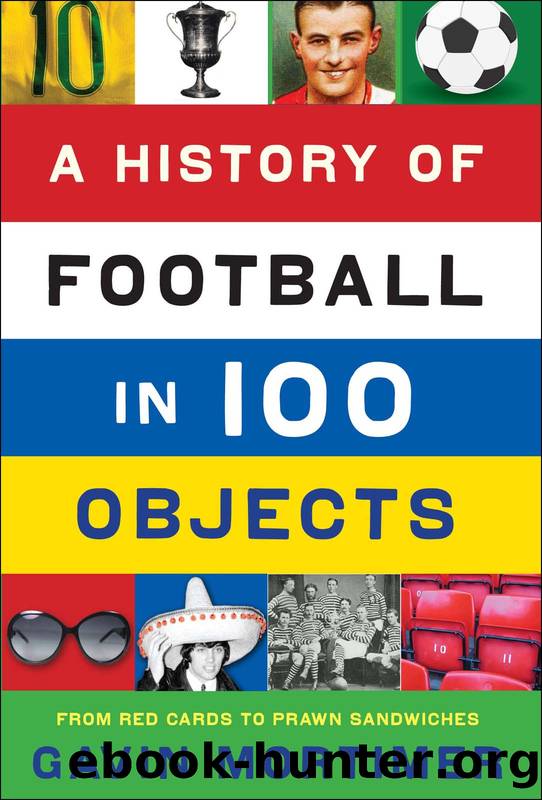A History of Football in 100 Objects by Gavin Mortimer

Author:Gavin Mortimer
Language: eng
Format: epub
Publisher: Profile
Published: 2012-01-15T00:00:00+00:00
World Cup Willie mascot
Our next object â and no sniggering at the back â is a Willie. Or to give it its full name âWorld Cup Willieâ. Described by the Daily Mirror in 1966 as âa lion with a Beatle haircut, a Union Jack jersey and an address somewhere in Yogi Bearâs Jellystone Park,â Willie was the official mascot for the 1966 World Cup finals held in England. It was the first time a mascot had graced the tournament and Willieâs presence in England was strangely at odds with the conservatism that so characterised the English game in the 1950s. The FA and the Football League had shown a stunning disdain for many of the sportâs key innovations: floodlights, the pools, television coverage and, above all, the new European club competitions. Even when England was awarded the hosting rights to the 1966 tournament there appeared a reluctance on the part of the FA to embrace the World Cup to its bosom. There were no new stadiums built and no desire to use the tournament to showcase England and the English game â except for their World Cup Willie.
The FA hired Walter Tuckwell & Associates to design a mascot for the tournament and officials briefed commercial artists Reg Hoye and Richard Culley at the firmâs London offices. As Culley later explained: âWe were given the task of creating a mascot to exploit merchandising beyond the insignia of the Jules Rimet trophy which was initially all we had to work with.â In less than five minutes the pair had rejected a bulldog for a lion, and in another five minutes Hoye had sketched World Cup Willie. In an era when British identity wasnât as divided as it is today, the fact that Willie was wearing the Union Jack Flag and not the English Cross of St George was irrelevant to Dennis Follows, the FA secretary, who approved the design.
It took a while for World Cup Willie to get off the ground. The conservative English public, not unlike the FA, was suspicious of innovation, and anyhow supporters didnât want mementos of a tournament few expected their boys to win. England had never progressed beyond the quarter-final stage in their four previous World Cup appearances and throughout the 1966 tournament their squad was more workman-like than wondrous. As Brian Granville writes in A History of the World Cup: âThough England may not at any time have matched the technique and artistry of the Brazilian teams which have won the two previous competitions, though they may have struggled all the way to the semi-final putting effort above creativity, hard work above joy in playing, the team had its undoubted stars.â
These included goalkeeper Gordon Banks, captain and left half Bobby Moore, inside forward Bobby Charlton, and midfielder Alan Ball. There was also Geoff Hurst, the young centre forward who replaced Jimmy Greaves from the quarter-finals onwards.
Coach of the side was Alf Ramsey, an awkward, insular man who often seemed at odds with the world. But he
Download
This site does not store any files on its server. We only index and link to content provided by other sites. Please contact the content providers to delete copyright contents if any and email us, we'll remove relevant links or contents immediately.
Relentless: A Memoir by Julian Edelman(1755)
The Source by James A. Michener(1491)
Cristiano Ronaldo: The Biography by Guillem Balague(1478)
ALEX FERGUSON My Autobiography by Alex Ferguson(1450)
1942 by Winston Groom(1416)
Football's Strangest Matches by Andrew Ward(1405)
When Pride Still Mattered by Maraniss David(1317)
Time's Champion by Time's Champion (Craig Hinton & Chris McKeon)(1221)
Chiefs by Stuart Woods(1219)
Where Men Win Glory: The Odyssey of Pat Tillman by Jon Krakauer(1143)
Gunslinger by Jeff Pearlman(1131)
0.721 by Gary Webster(1114)
Paterno by Joe Posnanski(1082)
Snake by Mike Freeman(1053)
Coming Back Stronger by Drew Brees & Drew Brees(1046)
Texas Monthly On… by Texas Monthly(1044)
League of Denial by Mark Fainaru-Wada(1018)
Deal Breaker by Harlan Coben(1010)
It Takes What It Takes by Trevor Moawad(1000)
